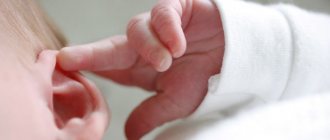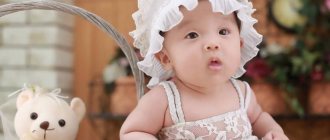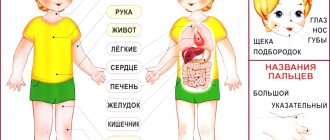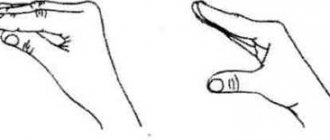Breathing is the energetic basis of spoken speech. The development of speech breathing largely determines the child’s formation of coherent speech, namely correct sound pronunciation, the ability to maintain normal speech volume, its smoothness and intonation expressiveness. By paying attention to establishing the correct speech breathing of the baby in early childhood, you can avoid many speech disorders in the future. In this article we will tell you about the features of speech breathing and ways of its development in preschool children.
Features of speech breathing in preschoolers
Speech breathing in preschool children differs from the breathing of adults and has its own characteristics:
- Insufficient development of the respiratory apparatus. If the inhalation and exhalation are weak, then the child’s speech will sound quiet and unintelligible. Sometimes, due to lack of air, children do not finish sentences. There are times when the baby tries to pronounce the entire phrase while inhaling, so he speaks quickly and does not observe logical pauses. Poor development of the respiratory system may be associated with the presence of chronic respiratory diseases in the child, such as sinusitis and sinusitis, as well as a sedentary lifestyle.
- Irrational distribution of exhaled air. Children who have recently learned to speak often run out of air on the first syllable, so they pronounce the end of a word or phrase much more quietly or even “swallow” it.
- Inability to distribute breathing according to words. To replenish the smell of the air, the child has to take a break, during which he may forget what he wanted to say.
- Speech sounds may be distorted due to improperly exhaled air.
Speech breathing in most preschool children is imperfect. But it is often difficult for parents to notice this due to the fact that they communicate with the baby constantly.
There are approximate norms for the number of words pronounced on exhalation, which can be used as a guide when assessing a baby’s speech breathing:
| Child's age | Number of words per exhale |
| 2-3 years | 2-3 words |
| 3-4 years | 3-5 words |
| 4-6 years | 4-6 words |
| 6-7 years | 5-7 words |
Breathing exercises developed by A.N. Strelnikova.
This author's technique is suitable for classes with children from 3 years old. The whole family can do it. The purpose of these exercises is to increase the volume of inhalation and diaphragmatic exhalation. Each movement corresponds to certain phases of breathing. So, inhalations are made with movements that compress the chest. Inhalation should be as active as possible, exhalation should be passive. A short, noisy breath is taken through the nose with slightly closed lips. Exhale freely through the mouth. All exercises are rhythmic. Each of them is performed 8 times, after a 3-5 second break it is recommended to move on to the next one. The total duration of gymnastics is 5-6 minutes. In the beginning, three exercises are mastered. On each subsequent day one more is added. The whole complex consists of 11 exercises:
1. “Palms” I.p.: stand up straight, raise your palms to face level, lower your elbows. Take a short, noisy, active breath through your nose and at the same time clench your fists. Exhale smoothly, freely, through the nose or mouth, unclench your fingers, relax your hands.
2. “Belt” I.p.: stand up straight, clench your fists, press them to the belt. At the moment of a short, noisy inhalation through your nose with force, sharply lower your fists down, as if throwing something off your hands. During the push, unclench your fists and spread your fingers. As you exhale, return to the starting position.
3. “Bow” IP: stand up straight, arms down. Lean forward slightly, round your back, lower your head and arms. Take a short, noisy breath at the end point of the bow. Then smoothly, exhaling freely through your nose or mouth, return to the starting position.
4. “Cat” I.p.: stand straight, hands at waist level, elbows slightly bent. Do light, springy squats, turning your torso to the right and then to the left. When turning, simultaneously take a short, noisy breath and make a throwing motion to the side with your hands. As you exhale, return to the starting position.
5. “Hug your shoulders” I.p.: stand up straight, bend your arms at the elbows at shoulder level, with your hands facing each other. At the moment of a short noisy inhalation, hug yourself by the shoulders with your nose (arms should move in parallel). As you exhale, return to the starting position.
6. “Big pendulum” IP: stand straight, arms down. Lean forward slightly, lower your hands to your knees - inhale noisily. Immediately lean back a little, bending slightly at the lower back, hugging yourself by the shoulders - take another breath. The exhalation is passive between two inhalations - movements. Return to starting position.
7. “Head turns” IP: stand straight, arms down. Turn your head to the right and take a short, noisy breath. Without stopping, turn your head to the left and take a short breath again. The inhalation is passive between two inhalations.
8. “Ears” IP: stand straight, look ahead. Slightly tilt your head towards your right shoulder - take a short, noisy breath in through your nose. Then tilt your head to the left - also inhale. Exhale passively between two inhalations, bend over without interruption.
9. “Small pendulum” IP: stand straight, arms down. Lower your head down, look at the floor - inhale. Throw your head up, look at the ceiling - also inhale. The exhalation is passive between inhalations, movements are made without stopping. Don't strain your neck.
10. “Rolls” IP: right leg in front, left leg one step behind. The weight of the body is on both legs. Shift the weight of your body to your front right leg. Sit lightly on it - inhale. Straighten up, transfer the weight of your body to your left leg standing behind you. Sit down lightly on it - inhale. Exhale passively between breaths. The exercise is performed 8 times without stopping. Change legs.
11. “Dance steps” I.p.: stand up straight, arms down along the body. Raise your right leg bent at the knee to the level of your stomach, squatting slightly on your left leg - inhale. Return to the starting position - passive free exhalation. Then squat on your right leg, raising your left leg - inhale. Exhale freely after each inhalation.
How to breathe correctly?
When diagnosing speech development, speech therapists always pay attention to how the child breathes during a conversation, the strength and duration of his inhalations and exhalations, and how he places pauses. Formation of speech breathing is one of the first stages of correctional work with a child who has any speech disorders. Correct speech breathing has the following signs:
- Short breath through the nose;
- Exhale smoothly, the air comes out through the mouth;
- Exhalation is carried out to the end;
- After each exhalation there should be a short pause (2-3 seconds).
The development of speech breathing is closely related to the functioning of physiological breathing.
| Physiological respiration | Speech breathing |
| Involuntary | free |
| Inhale - exhale - pause | Inhale - pause - exhale |
| Inhalation and exhalation are carried out in one impulse. | Inhalation is carried out with one impulse, exhalation - with several (depending on the content of the statement). |
Only by learning to breathe correctly (deep short inhalation and smooth long exhalation) will a child be able to fully master his voice. The most effective methods of working with preschoolers are breathing exercises. Conventionally, they can be divided into two large groups, depending on their purpose:
- Formation of correct exhalation;
- Breathing training using various speech materials (practicing the pronunciation of sounds and their combinations, learning poetry).
The development of speech breathing in preschoolers allows:
- Speed up the process of staging and automating speech sounds;
- Increase the number of words that the baby pronounces in one exhalation;
- Form intelligible, coherent speech;
- Coordinate the processes of speech, breathing and movements.
Gymnastics for children 6-9 months
In addition to the exercises already described:
Breathing exercises are done on your back, on your side, or start while sitting.
Simultaneous and alternate abduction of the arms to the sides, upwards, grasping movements with the arms.
All exercises for the legs are performed: “stomps”, sliding steps, circular movements of the legs, alternating flexion and extension.
A new exercise is introduced: cycling.
Starting position: on your back. With the child's legs bent at the hip and knee joints, circular movements are performed, reminiscent of the movement of the legs while riding a bicycle.
In a sitting position (in a tailor's position, when the feet are joined or in a Turkish position), the child is rocked using a toy and encouraged to stretch after it.
Try in every possible way to encourage your baby to actively turn from back to stomach and back.
An exercise aimed at developing crawling skills is useful. During this period of time, you can help the child by substituting your palm as a support.
Exercises are performed to develop walking: stepping from foot to foot is stimulated, while the adult first supports the child’s armpits, and subsequently, the hands of both hands.
In exercises on the ball: you can use swinging on it in a sitting position.
Recommendations for performing breathing exercises
- Classes must be carried out in a well-ventilated area;
- All exercises should be performed before meals;
- Clothing should not hinder the baby's movements;
- The muscles of the child’s neck, shoulders, arms, chest and abdomen should be relaxed;
- Inhalation should occur through the nose;
- The exhalation should be long and smooth;
- Make sure that when performing breathing exercises, the child does not puff out his cheeks. At first, you can hold them with your palms;
- 3-5 repetitions of each exercise are enough, between which you should take a 2-3 second pause. The total duration of breathing exercises should not exceed 5 minutes.
It is very important to measure the amount of breathing exercises and perform them at a moderate pace to avoid hyperventilation.
Gymnastics for children 4-6 months
Unconditioned reflexes gradually fade away, so the proportion of passive-active exercises increases. The number of repetitions of the same exercise also increases.
Passive exercises are performed - flexion and extension in large joints.
Circular movements in the hip joints, with the obligatory fixation of the child’s knees with your own hands.
Simultaneous flexion - extension of the legs.
Starting position: on your back. You should grab the child's legs at the bottom of the lower leg from behind, holding the feet. Bend your legs at all joints, pressing them lightly towards your stomach (the baby's knees should be spread apart), then straighten the baby's legs.
Connection of opposite and identical knee-elbow.
The range of exercises on the ball is expanding.
At this age, many children swing with interest on the ball while lifting the toy from the surface.
On the ball in a position on the back, you can rock the baby with a slight “squat” when the legs reach support.
From 5 months, you can rock the baby on its side, pushing off the support surface.
Exercises to develop the strength and duration of exhalation
- Breeze. Tie several ribbons of serpentine or Christmas tree rain to a thread or lace. Invite your baby to blow on them and create a breeze. You can make the task more difficult by asking them to blow on ribbons of a certain color. The distance between the face and the ribbons should be approximately 10-15 cm.
- Leaf fall. Cut out real autumn leaves from paper or collect them from the street. Together with your child, you can arrange a real leaf fall by blowing them off the table. In the winter season, you can also play with paper snowflakes.
- Fly, feather! Let the baby throw the feather up and blow on it from bottom to top, not letting it fall.
- Pencil athletes. Draw start and finish lines on the table. At the start, put two pencils of different colors. Take turns blowing with your child on his own pencil and arrange a competition to see which of them will “run” to the finish line first.
- Sailors. Make boats out of paper or cork and lower them into a basin of water. There is a strong wind at sea - we blow on the ships, forcing them to move.
- Blow out the candles. You can role-play a birthday situation with your child. Prepare a toy set, cake and real candles. By blowing out the candles, you can make a wish.
- Pinwheel. A fidget toy is great for creating proper exhalation. Children love to watch the rotating blades and are proud of the result of their efforts.
- Whistles with the sounds of various animals and birds will also delight the baby and will be very useful for the development of his speech breathing.
- Another simple way to practice breathing is using soap bubbles.
Make sure that the child makes smooth and long exhalations. Gradually make the exercises more difficult by increasing the distance between your face and the object being deflated.
Working on breathing: exercises for children
In any sport, breathing exercises are basic.
Not a single physical education lesson in a preschool institution is complete without breathing exercises. After all, regular exercise improves immunity and reduces the frequency of colds.
Below you will find exercises for preschoolers that will help develop the speech apparatus and full deep breathing. All exercises are built in the form of a game, so kids usually do them with pleasure. You can easily do them at home yourself.
Exercises to practice correct pronunciation of sounds and syllables
To teach your baby to correctly pronounce vowels and consonants, syllables and sound combinations, you need to train them to pronounce them in one exhalation. Invite your baby to sing “songs” that imitate various sounds:
- “Ahhh!” - the baby is crying;
- "Uh-oh!" - the plane is flying;
- “Y-y-y!” — the steamer is humming;
- “Oh-oh-oh,” the bunny sighs;
- “F-f-f” - the balloon deflates;
- “Sh-sh-sh” - the snake hisses;
- “Ssss” - the pump is running;
- “Beep!” - the car honks;
- “Too-too” - the locomotive is moving;
- “La-la-la” - the doll sings;
- “Top-top-top” - the bear goes;
- “Drip-drip-drip” - it’s raining.
To engage your child, create a playful situation using your child’s favorite toys in class. Reinforce your speech with appropriate actions, and let the baby repeat after you.






